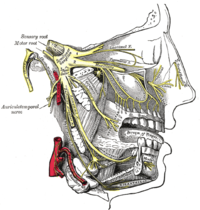
Photo from wikipedia
BACKGROUND AND OBJECTIVE Various surgical routes have been used to decompress the intracanalicular optic nerve. Historically, a transcranial corridor was used, but more recently, ventral approaches (endonasal and/or transorbital) have… Click to show full abstract
BACKGROUND AND OBJECTIVE Various surgical routes have been used to decompress the intracanalicular optic nerve. Historically, a transcranial corridor was used, but more recently, ventral approaches (endonasal and/or transorbital) have been proposed, individually or in combination. The present study aims to detail and quantify the amount of bony optic canal removal that may be achieved via transcranial, transorbital, and endonasal pathways. In addition, the surgical freedom of each approach was analyzed. METHODS In 10 cadaveric specimens (20 canals), optic canals were decompressed via pterional, endoscopic endonasal, and endoscopic superior eyelid transorbital corridors. The surgical freedom and circumferential optic canal decompression afforded by each approach was quantitatively analyzed. Statistical comparison was carried using a nonpaired Student t test. RESULTS An open pterional transcranial approach allowed the greatest area of surgical freedom (transcranial, 109.4 ± 33.6 cm2; transorbital, 37.2 ± 4.9 cm2; endonasal homolateral, 10.9 ± 5.2 cm2; and endonasal contralateral, 11.1 ± 5.6 cm2) with widest optic canal decompression compared with the other 2 ventral routes (transcranial, 245.2; transorbital, 177.9; endonasal, 144.6). These differences reached, in many cases, statistical significance for the transcranial approach. CONCLUSIONS This anatomic contribution provides a comprehensive evaluation of surgical access to the optic canal via 3 distinct, but complementary, approaches: transcranial, transorbital, and endonasal. Our results show that, as expected, a transcranial approach achieved the widest degree of circumferential optic canal decompression and the greatest surgical freedom for manipulation of surgical instruments. Further surgical experience is necessary to determine the proper surgical indication for the transorbital approach to this disease.
Journal Title: World neurosurgery
Year Published: 2017
Link to full text (if available)
Share on Social Media: Sign Up to like & get
recommendations!